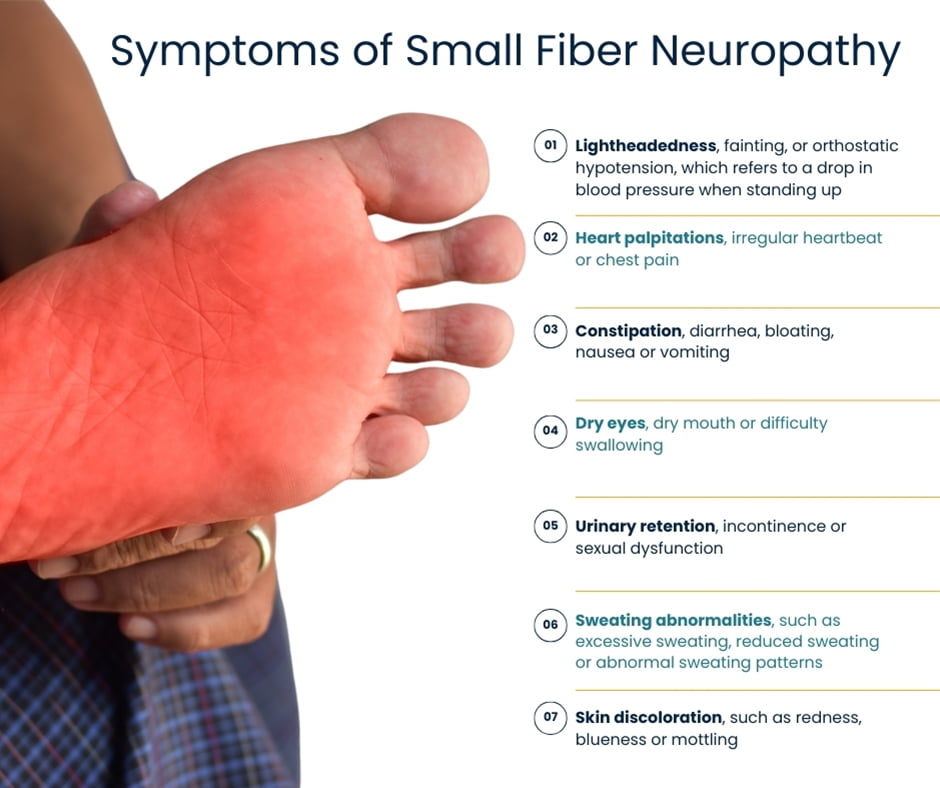Small fiber neuropathy causes debilitating pain and can put you out of commission without effective small fiber neuropathy treatment. You need an experienced pain management small fiber neuropathy specialist to diagnose the condition and offer new treatment for small fiber neuropathy, such as peripheral nerve stimulation or spinal cord stimulation. In the New York City area, call Pain Management NYC for the most up-to-date diagnostic services and treatment of small fiber neuropathy.
What Is Small Fiber Neuropathy?
Small fiber neuropathy (SFN) is a condition that affects the small nerve fibers in your skin, organs and peripheral nervous system. These fibers are responsible for transmitting pain, temperature and touch sensations, as well as regulating autonomic functions, such as blood pressure, heart rate and digestion. When these fibers are damaged or malfunctioning, they can cause a variety of symptoms, such as burning, tingling, numbness or electric shock-like sensations in the affected areas.
Pain Management NYC is a top medical practice that specializes in treatment for small fiber neuropathy and other chronic pain conditions. This team offers new treatment for small fiber neuropathy using the latest technology and methods. They offer various treatment options, such as medications, nerve blocks, spinal cord stimulation and support for lifestyle modifications and education to help you manage your condition and improve your well-being.
What Causes Small Fiber Neuropathy?
The exact cause of SFN is not always known. Sometimes, it’s the result of nerve damage from another underlying medical condition, such as diabetes, an autoimmune disease or an infection. Other times, it’s due to inherited genetic mutations that affect the function of the small nerve fibers. If the cause of SFN is not identified, it’s called idiopathic SFN.
Following a battery of tests and an in-depth medical and family history, your small fiber neuropathy specialist may determine that the cause of your SFN comes from:
- Diabetes. Diabetes is the most common cause of SFN, as high blood sugar levels can damage the small nerve fibers over time and lead to diabetic neuropathy.
- Endocrine and metabolic disorders. Conditions that affect the hormone levels or metabolism, such as hypothyroidism, metabolic syndrome or vitamin B12 deficiency, can also cause SFN.
- Immune system disorders. Some autoimmune diseases, such as celiac disease, sarcoidosis, Sjogren’s syndrome and rheumatoid arthritis, can cause inflammation and damage to the small nerve fibers.
- Infectious diseases. Some infections, such as hepatitis C, HIV or Lyme disease, can also damage the small nerve fibers and cause SFN. These infections also weaken the immune system and make the body even more susceptible.
- Inherited disorders. Some genetic mutations can cause SFN by affecting the structure or function of the small nerve fibers. These mutations can be inherited from one or both parents or occur spontaneously. Some examples of inherited disorders that can cause SFN are Fabry disease, hereditary amyloidosis, hereditary sensory autonomic neuropathy and Tangier disease.
What Are the Symptoms of Small Fiber Neuropathy?
Small fiber neuropathy causes various sensory and autonomic symptoms, depending on which nerve fibers are affected and how severely. The most common symptom of SFN is pain, which can be described as burning, tingling, prickling, electric-shock or pins-and-needles sensations. The pain usually starts in the feet and progresses up the legs; it can also affect the hands and arms.
The pain can be constant or intermittent and triggered or worsened by touch, temperature or movement. Some people with SFN may also experience numbness or loss of sensation in some parts of the body, especially the feet and lower legs. In addition to sensory symptoms, SFN can also affect the autonomic nervous system.
Some of the autonomic symptoms of SFN include:
- Lightheadedness, fainting, or orthostatic hypotension, which refers to a drop in blood pressure when standing up
- Heart palpitations, irregular heartbeat or chest pain
- Constipation, diarrhea, bloating, nausea or vomiting
- Dry eyes, dry mouth or difficulty swallowing
- Urinary retention, incontinence or sexual dysfunction
- Sweating abnormalities, such as excessive sweating, reduced sweating or abnormal sweating patterns
- Skin discoloration, such as redness, blueness or mottling

What Are the Long-Term Effects of Untreated Small Fiber Neuropathy?
Small fiber neuropathy (SFN) can cause a lot of discomfort and distress and lead to serious complications if you don’t receive sufficient small fiber neuropathy treatment. These complications worsen your quality of life and increase the risk of morbidity and mortality.
Therefore, it’s important to seek medical attention and treatment for small fiber neuropathy as soon as possible if you experience any symptoms of SFN.
Some of the possible complications brought on by untreated SFN include:
- Injuries and infections. Because SFN causes other problems like neuropathy in feet and other peripheral neuropathy conditions, you may not notice minor cuts, blisters or burns. These can become infected and cause ulcers, gangrene or amputation if not treated promptly.
- Cardiovascular problems. SFN can affect the autonomic nervous system, which regulates your heart rate and blood pressure. This can cause orthostatic hypotension, leading to dizziness, fainting or falls. It can also cause arrhythmias, which are irregular heartbeats, or angina, which is chest pain due to reduced blood flow to the heart.
- Gastrointestinal problems. SFN can also affect the autonomic nervous system, which controls digestion and bowel movements. This leads to constipation, diarrhea, nausea, vomiting or gastroparesis, which is delayed stomach emptying. These can lead to malnutrition, dehydration or unwanted weight loss.
- Urinary and sexual problems. The autonomic nervous system also regulates the bladder and sexual function. SFN can lead to urinary retention, which is difficulty emptying the bladder completely, or incontinence, which is loss of bladder control. It can also cause erectile dysfunction in men or vaginal dryness in women, affecting sexual performance and satisfaction.
What Small Fiber Neuropathy Treatment Is Available?
The treatment of small fiber neuropathy depends on the underlying cause and the severity of the symptoms. The main goals of small fiber neuropathy treatment are to control the pain and discomfort caused by the condition and treat the underlying condition or disorder that’s causing SFN. Effective treatment also prevents or delays the progression of SFN and its complications.
Some of the available treatment for small fiber neuropathy and new treatment for small fiber neuropathy include:
- Medications. Various medications reduce the pain and sensory symptoms of SFN, and may be given in the form of antiseizure drugs, lidocaine creams or pain patches. These medications work by blocking or modifying the nerve signals that transmit pain sensations to the brain.
- Nerve blocks. Nerve blocks are injections of local anesthetics or steroids into specific nerves or nerve clusters that are affected by SFN. These injections temporarily numb the nerves and provide relief from pain and inflammation for extended periods of time.
- Lifestyle modifications. Lifestyle modifications supplement treatment of small fiber neuropathy to manage the symptoms and prevent the worsening of SFN. These include limiting alcohol intake, quitting smoking, eating a balanced diet and exercising regularly.
Pain Management NYC is a leading medical practice that specializes in diagnosing and treating SFN and other chronic pain conditions. They offer a range of effective treatment options for SFN and other nerve problems and pain disorders. Contact your small fiber neuropathy specialist at Pain Management NYC today to schedule an appointment with a small fiber neuropathy specialist and get the best small fiber neuropathy treatment.

Boleslav Kosharskyy, MD, is a top-rated, best-in-class interventional pain management doctor. He is board-certified in Anesthesiology, Interventional Pain Medicine, and Palliative Care.
Dr. Kosharskyy is an Associate Professor of Anesthesiology and Rehabilitation Medicine at Albert Einstein Medical College. He’s also the Associate Medical Director of Pain Medicine and Director of Anesthesia for the Joint Replacement Center at Montefiore Medical Center and Albert Einstein Medical College.
He is an active member of the American Society of Anesthesiology (ASA), the American Society of Regional Anesthesia and Pain Medicine (ASRA), and the New York State Society of Anesthesiologists (NYSSA)
